
Elias Hicks was a traveling Quaker minister from Long Island, New York. In his ministry he promoted unorthodox doctrines that led to controversy, which caused the second major schism within the Religious Society of Friends. Elias Hicks was the older cousin of the painter Edward Hicks.

The Yearly Meeting of the Religious Society of Friends (Quakers) in Britain, also known as Britain Yearly Meeting, is a Yearly Meeting of the Religious Society of Friends (Quakers) in England, Scotland, Wales, the Channel Islands and the Isle of Man. It is the national organisation of Quakers living in Britain. Britain Yearly Meeting refers to both the religious gathering and the organisation. "Yearly Meeting", or "Yearly Meeting Gathering" are usually the names given to the annual gathering of British Quakers. Quakers in Britain is the name the organisation is commonly known by.
The Religious Society of Friends began as a proto-evangelical Christian movement in England in the mid-17th century in Ulverston. Members are informally known as Quakers, as they were said "to tremble in the way of the Lord". The movement in its early days faced strong opposition and persecution, but it continued to expand across the British Isles and then in the Americas and Africa.

The Free Church is a building located in Hampstead Garden Suburb, Barnet, London. It was built to a design by Sir Edwin Lutyens starting in 1911, and, like St Jude's Church at the opposite side of Central Square, is a Grade I listed building.

Quakers are people who belong to the Religious Society of Friends, a historically Christian denomination. Members of this movement are generally united by a belief in each person's ability to experience the light within or "Inner Christ". They include branches with evangelical, liberal, and "Conservative" theology. Friends do not have creeds and tend to non-hierarchical structures.
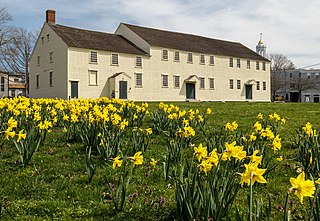
A Friends meeting house is a meeting house of the Religious Society of Friends (Quakers), where meeting for worship is usually held.
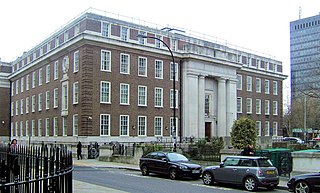
Friends House is a multi-use building at 173 Euston Road in London, England. The building houses the central offices of British Quakers and a conference centre. The building is also the principal venue for North West London Meeting and the Britain Yearly Meeting.

The Brighton Friends Meeting House is a Friends meeting house in the centre of Brighton, part of the city of Brighton and Hove in East Sussex, England. The building, which dates from 1805, replaced an earlier meeting house of 1690 what was then a small fishing village on the Sussex coast. Located at the junction of Ship Street and Prince Albert Street in The Lanes, the heart of Brighton's "old town" area, its architectural and historic importance has been recognised by English Heritage's granting of Grade II listed status.

Appoquinimink Friends Meetinghouse, also known as the Odessa Friends Meetinghouse, is a very small but historic Quaker meetinghouse on Main Street in Odessa, Delaware. It was built in 1785 by David Wilson and added to the National Register of Historic Places in 1972. Members of the meeting, including John Hunn and his cousin John Alston, were active in the Underground Railroad and Harriet Tubman may have hid in the meetinghouse. Measuring about 20 feet (6.1 m) by 22 feet (6.7 m), it may be the smallest brick house of worship in the United States.
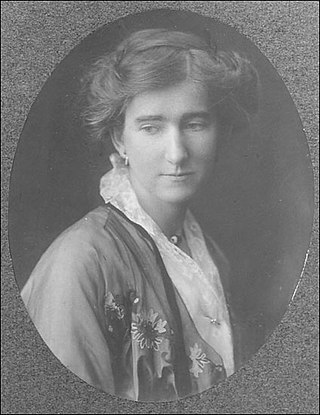
Mary Ursula Bethell, was a New Zealand social worker and poet. She settled at the age of 50 at Rise Cottage on the Cashmere Hills near Christchurch, with her companion Effie Pollen, where she created a sheltered garden with views over the city and towards the Southern Alps, and began writing poems about the landscape. Although she considered herself "by birth and choice English", and spent her life travelling between England and New Zealand, she was one of the first distinctively New Zealand poets, seen today as a pioneer of its modern poetry.
Job Scott was an eminent traveling minister in the Religious Society of Friends and a prominent American quietist. His religious philosophy had a deep, shaping influence that contributed to the first schism in American Quakerism, the 1827 Hicksite-Orthodox split.
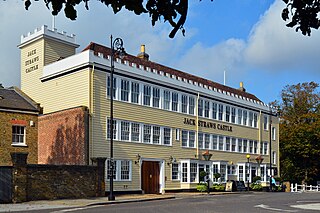
Jack Straw's Castle is a Grade II listed building and former public house on North End Way, Hampstead, north-west London, England close to the junction with Heath Street and Spaniards Road.

Zeng Baosun or Tseng Pao Swen was a Chinese feminist, historian, and Christian educator.

Godalming Friends Meeting House is a Friends meeting house in the ancient town of Godalming in the English county of Surrey. One of many Nonconformist places of worship in the town, it dates from 1748 but houses a congregation whose roots go back nearly a century earlier. Decline set in during the 19th century and the meeting house passed out of Quaker use for nearly 60 years, but in 1926 the cause was reactivated and since then an unbroken history of Quaker worship has been maintained. Many improvements were carried out in the 20th century to the simple brick-built meeting house, which is Grade II-listed in view of its architectural and historical importance.
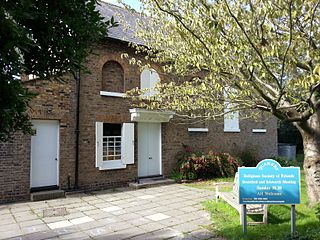
The Brentford & Isleworth Meeting House is a Friends meeting house on Quakers Lane in Isleworth, Hounslow. It is listed Grade II* on the National Heritage List for England, and is one of the oldest purpose-built meeting houses in London. Meeting for worship is held on Sundays at 10:30 am.

The Finchley Meeting House is a Friends meeting house at 58 Alexandra Grove in Finchley, London N12.

Westminster Quaker Meeting House is a place of worship of the Religious Society of Friends located behind 52 St Martin's Lane in Covent Garden, London WC2. It shares its frontage with an adjoining shop. Westminster Quakers have been meeting at this location since 1883.

Endsleigh Gardens is a street in the Bloomsbury district of central London, in the London Borough of Camden. It runs south-west to north-east from Gordon Street to Woburn Place. The south-west end becomes Gower Place after the junction with Gordon Street. Taviton Street and Endsleigh Street run off the south side.

Mount Vernon House is a house in Hampstead in the London Borough of Camden. It has been listed Grade II on the National Heritage List for England (NHLE) since May 1974. The garden wall is separately listed at Grade II. The house was built around 1726 and was altered in the early 19th century. It is rendered in stucco with a mansard roof. The house occupies the site of a windmill. It was constructed between 1725 and 1728 by a local Hampstead timbersmith, William Knight.

The Quaker business method or Quaker decision-making isione of the first form of group decision-making and discernment, as well as of Direct democracy, used by Quakers, or 'members of the Religious Society of Friends', since the sixteenth century, to organise their religious affairs. It is primarily carried out in meetings for worship for business, which are regular gatherings where minutes are drafted, to record collective decisions.


















